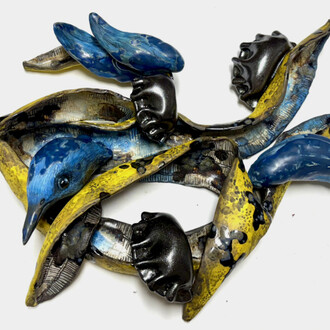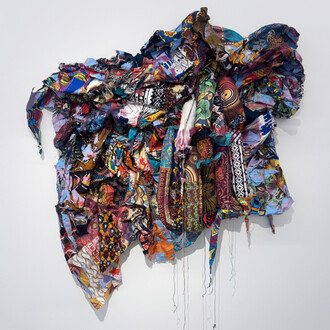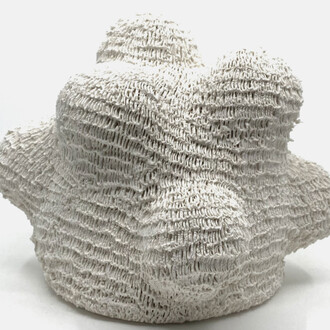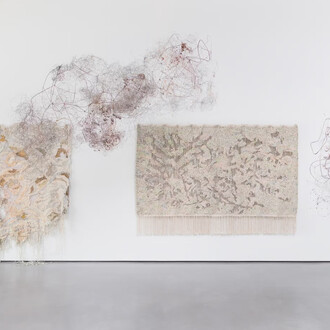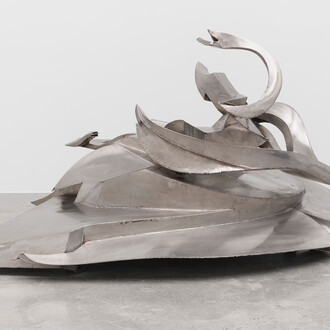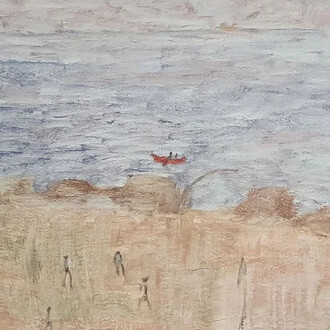An exhibition about the stuff of womanhood.
We measure ourselves by our perception of someone else’s standards. We don’t see ourselves as beautiful. We see ourselves as flawed. We focus on our imperfections. Our asymmetry. We feel one way and look another. Sometimes we think our lady parts are inadequate. Sometimes we are not even sure what it means to be lady. In fact, I have left my lady filter at the door in favor of a newer bolder style I like to think of neurotic, self-deprecating empowerment. What are our Lady Parts really? Heart? Mind? Do we cease to be ladies if we don’t adhere to the societal definitions of beauty and behavior? What if we find ourselves without a relationship? How does that impact our “ladiness”?
Shona McAndrew’s painted papier-mâché sculptures, installations and paintings depict women in quiet private moments. Often life-size or slightly larger, her work draws from personal experiences to call attention to the simultaneous banality and importance of fleeting, introspective, honest and vulnerable moments. McAndrew recreates historical poses with the help of her friends and peers in states of reveal in an unbroken stream of daydreams. Unembarrassed by their often exposed bodies and seemingly unaware and unconcerned about the viewer’s careless voyeurism, Shona’s women ask us to valorize activities of body exploration, self care and forgetting to see oneself through the critical eyes of others.
Ana Weider-Blank chooses historical narrative to illustrate her relationship to self and the condition of women. “I am working on series of oil paintings, ceramic sculptures, performances, and works on paper interpreting mythology with a feminist analysis. These components often come together to create installation pieces. I change, distort, and extend narratives past their end to create contemporary political allegory. Though I am still deeply invested in creating the individual art piece, those pieces now are largely made in the service of larger installations. I work with narratives from the bible, Greek, Mexican and Indian Mythologies, and fairy tales. These stories are loaded with political, gender and sexual allegories that are as potent today as they ever were. I am particularly interested in narratives that deal with ideas of outsider marginalization, queer sexuality, environmental concerns and issues of rape and consent. I couple womyn characters together and explore dynamics of hidden and overt love, jealousy, and escape of patriarchy.
Hannah McBroom is a visual artist working primarily in the realm of self-portraiture and narrative, McBroom seeks to depict the transgender body as familiar. Exploring her understanding of her being while investigating the politics of trans and cis culture, her paintings are the site of these explorations. In her paintings, she looks for an active movement between image and paint by reworking the physicality of these two materials. Her recent series explores the identities and themes within trans pornography and the way bodies are depicted in and outside this industry. Color and light are used to create a sense of fantasy and familiarity within her paintings. She uses her body and others to find a way for a person under surveillance to find authorship in one’s sexuality through her paintings.
Virginia Leonard’s sculptures convey stories of personal tragedy and renewal infused with gory autobiographical detail that can be decoded by those literate in bodily pain. The origin story of her work takes place in 1986, London. She was involved in a serious motorcycle accident. Within her practice chance and accident are embraced as methodologies. Physical violence is enacted on the raku clay body, which is pummelled and punctured and slammed into the kiln. Tendrils snap off, breakages occur and their remnants are worked into the overall scheme. This punk rock sensibility flies in the face of well-mannered craft practice and gives voice to a newly born independent female with no fucks to give.
Mequitta Ahuja turns the artist’s self-portrait; especially the woman-of-color’s self-portrait, long defined by identity, into a discourse on picture making. She does this by visually cataloging painting conventions while using those conventions to make new meanings. Her work, Crying Portrait, featured in the exhibition, exemplifies a re-envisioning of female depiction in art. Ahuja describes the larger body of work that Crying Portrait came from: By recasting the figures in Picasso’s Les Demoiselles D’Avignon with my own body, a woman of color as both subject and artist, I reclaim the territory Picasso borrowed from the black body and from black creative production. I see this as a decolonizing act. By shifting the perspective of the gaze from man looking at woman to woman analyzing and presenting her experience with her own body, my work is a corrective to the sexual objectification of Les Demoiselles D’Avignon
Super Future Kid is the gender-neutral nom de plume for this female identified artist. For Lady Parts, SFK poses the question of what it means to be a lady. Per definition one is required to be refined, polite and soft spoken. SFK’s paintings debunk that stereotype by creating women that appear more like characters- boldly colored, disproportioned and visibly charismatic. Her work puts fun and play first and femininity second.
Born in Saudi Arabia but originally from Pakistan, Nadia Waheed makes large scale allegorical figurative paintings that are partially autobiographical and explore female selfhood, vulnerability, and cultural trauma. “While for the majority of my life I’ve lived in the Western world I am reluctant to wholly be a part of it. I fundamentally disagreed with my categorization after moving to the US in the midst of rampant Islamophobia post 9/11 and I felt othered from the outset. Simultaneously my experiences within the Pakistani community here were harsh, critical and overall fundamentally unloving, labeling me as immoral and shameful. The one dimensional stereotypes I contended with daily from both sides as a progressive young woman were shackles, especially as one who aspired to work in the arts.”





